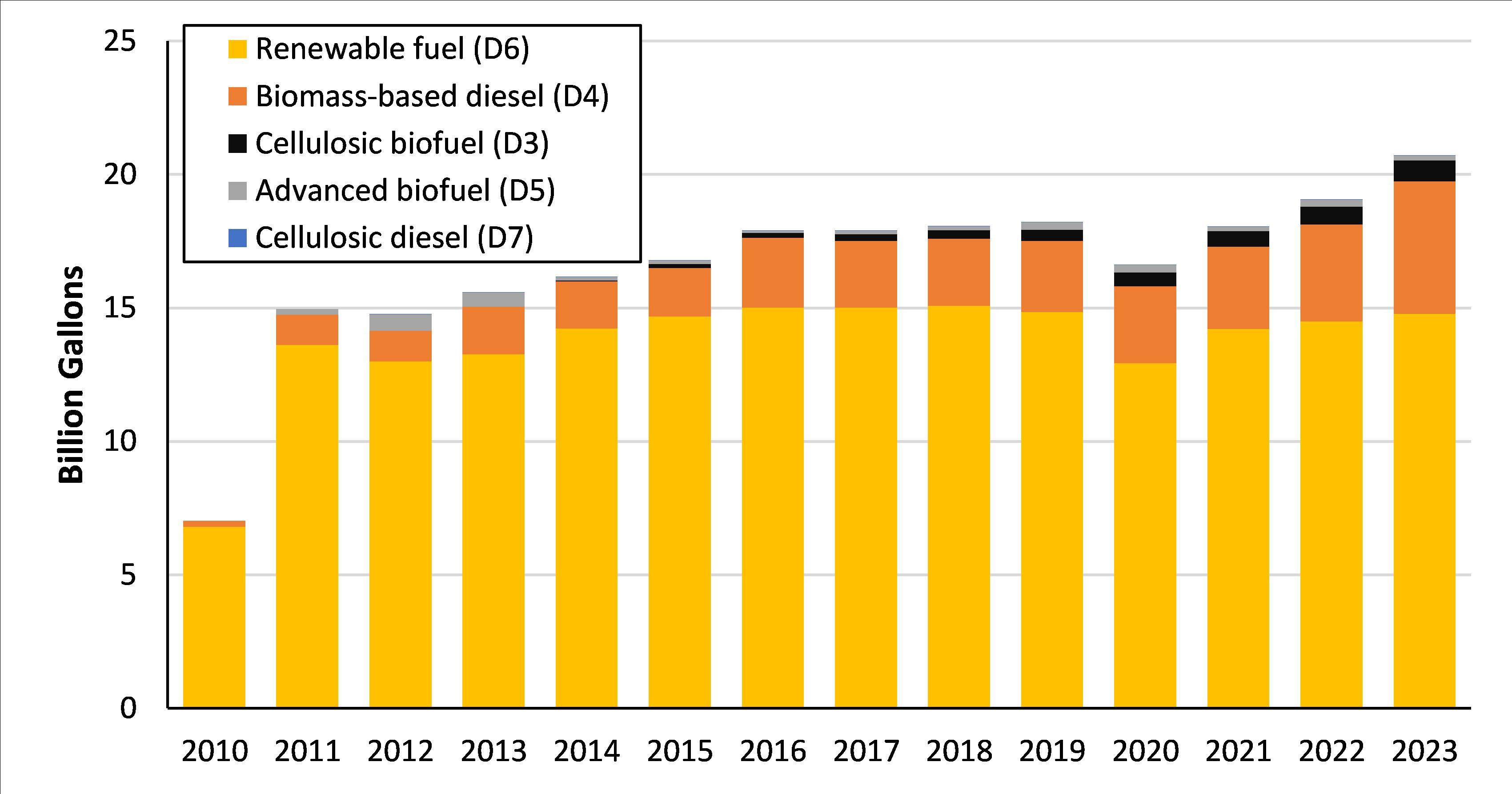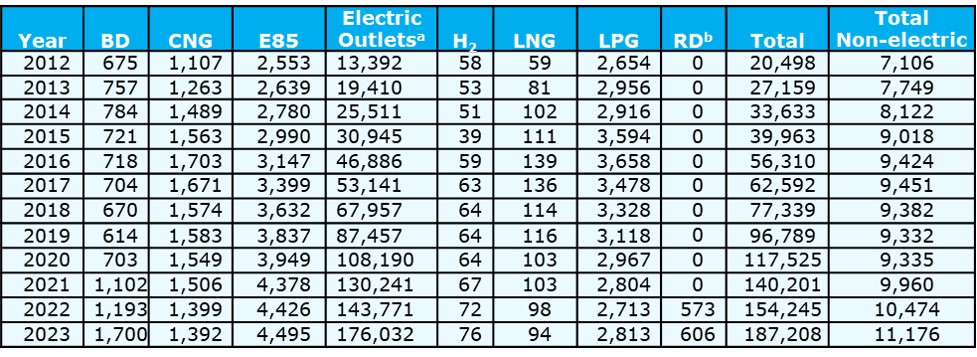Advanced Motor Fuels in United States
Drivers and Policies
The Biden Administration seeks to reduce U.S. greenhouse gas (GHG) emissions to net zero on an economy-wide basis by 2050. Playing a critical role in achieving this goal is the transportation sector, the largest contributor to U.S. GHG emissions. At the same time, consumer utility and affordability must be maintained, especially as the administration focuses on the redress of historical inequities. This monumental effort is seen as a vital response to the climate crisis.
In 2021, the U.S. Congress enacted the Bipartisan Infrastructure Law (BIL). The law establishes aggressive goals for transportation electrification and decarbonization with significant federal government investments in battery electric vehicles (BEVs), charging stations, hydrogen fuel cell vehicles (FCVs), and hydrogen production deployment. Under the law, the federal government will develop partnerships and provide financial assistance through competitive grants to state governments and industry to meet these goals. The following year, Congress enacted the Inflation Reduction Act (IRA), the single largest investment in climate and energy in U.S. history. Included in the legislation are several tax credits supporting alternative fuel vehicles and infrastructure, support of fleet acquisition of clean and zero-emission vehicles, and support of domestic manufacturing of clean vehicles and their battery supply chain. The IRA also established incentives for the production and use of sustainable aviation fuels, clean hydrogen, and clean fuels. The incentive levels for these fuels are based on their life-cycle GHG emissions. Together, the BIL and IRA are projected to lower economy-wide emissions by more than 40% by 2030, relative to 2005 levels.
In 2022, the U.S. Department of Energy (DOE), Department of Transportation, Environmental Protection Agency (EPA), and Department of Housing and Urban Development signed a joint memorandum of understanding to formalize the Administration’s commitment to collaboration and coordination on transportation decarbonization. The four agencies published a decarbonization strategy for the entire transportation sector to guide future policymaking and research, development, demonstration, and deployment (RDD&D) in the public and private sectors.[1] The blueprint’s strategy is built on five guiding principles:
- Implement bold actions to achieve measurable results.
- Embrace creative solutions across the entire transportation system.
- Ensure safety, equity, and access.
- Increase collaboration.
- Establish U.S. leadership.
The agencies also defined six categories of levers they can pursue to decarbonize the transportation sector: (1) policy and regulation; (2) infrastructure, industrial investments, and financing; (3) research and innovation; (4) data and analytic tools; (5) workforce education and training; and (6) stakeholder engagement and public-private partnerships.
The Energy Policy Act of 1992 requires certain centrally fueled fleets (federal, state, and alternative fuel provider fleets, such as those used by utility companies) to acquire light-duty alternative fuel vehicles (AFVs) as most of their new vehicle acquisitions. AFVs are promoted for their benefits for emission reductions, energy diversification, and low operating costs.
The DOE Technology Integration Program is a government-industry partnership that supports local decisions to reduce petroleum use and GHGs in the transportation sector through the use of alternative fuels, hybrid and electric-drive vehicles, idle reduction technologies, smarter driving practices, and improved fuel economy measures. Data from the Technology Integration Program for 2022 reveal that the program saved 1,066 million gasoline gallons equivalent (GGE), including 745 million GGE from alternative fuels/vehicles and 128 million GGE from electric and hybrid vehicles.
The transportation sector continues to use a large amount of renewable fuels. The primary driver of renewable fuel use in the United States is the Renewable Fuel Standard (RFS), adopted in 2005 and expanded in 2007 (RFS2). The Standard requires the use of increasing volumes of renewable fuels in motor fuels. On June 1, 2022, the EPA finalized a slight increase of total renewable fuel volumes from 20.6 billion gallons in 2022 to 20.9 billion gallons in 2023.[2] In addition, the EPA set 2024 and 2025 volumes to 21.5 billion gallons and 22.3 billion gallons, respectively. The 2023 volume is significantly lower than the original target of 36 billion gallons in the RFS legislation, which envisioned much more robust growth in cellulosic fuel production than has materialized.
The cellulosic biofuel category in the RFS was created largely with cellulosic ethanol in mind. However, renewable natural gas from landfills and anaerobic digesters, treated as cellulosic biofuel by the EPA through rulemakings in 2013 and 2014, has dwarfed liquid fuels in that category. Biomass-based diesel is mainly traditional biodiesel derived from soy, corn oil, canola, and other vegetable and animal fats and oils. These categories are nested into the category of advanced biofuels, which also includes renewable diesel, biogas, renewable heating oil, and renewable fuels co-processed in petroleum refining. Finally, the broad category “renewable fuel” includes all of these categories combined with starch- and sugar-based ethanol.
The State of California developed the Low-Carbon Fuel Standard (LCFS) to reduce the average carbon intensity of its transportation fuels by 10% from 2010 to 2020. In 2019, California extended the LCFS to 2030 with reduced carbon intensities for transportation fuels by an additional 10%. Using life-cycle analysis, California developed carbon intensities for different fuels, including alternative fuels and biofuels. With both the RFS and LCFS, a significant volume of biofuels — about 3.1 billion GGE — was used in California in 2022, which was 20% higher than in 2021.
Advanced Motor Fuels Statistics
The U.S. Energy Information Administration (EIA) estimated that total U.S. transportation energy consumption for 2023 was 28,057 trillion British thermal units (Btu) — 2% higher than in 2022.[3] About 90% of this consumption is petroleum-based fuels (gasoline and diesel), with much of the remainder being ethanol blended into gasoline at 10%. Biomass accounted for 1,788 trillion Btu during 2023, natural gas for 1,322 trillion Btu, electricity for 57 trillion Btu, and propane for 10 trillion Btu.[4]
Biofuels
The best biofuel use data come from the EPA’s recording of Renewable Identification Numbers (RINs) filed by refiner/marketers of liquid transportation fuels, as shown in Figure 1.[5] Each RIN is equivalent to 1 gallon of ethanol by Btu content; RINs are generated when a motor fuel refiner/blender blends or sells the renewable fuel or fuel blend. Renewable fuel volumes grew from 19.1 billion gallons in 2022 to 20.7 billion gallons in 2023, as fuel consumption continued to grow after the first year of the pandemic.
 Figure 1. Renewable Fuel Volumes Resulting from U.S. Renewable Fuel Standard
Figure 1. Renewable Fuel Volumes Resulting from U.S. Renewable Fuel Standard
Electric Vehicles
Sales of plug-in hybrid electric vehicles (PHEVs) and BEVs in 2023, totaling 1,432,657, resulted in the largest EV sales year in U.S. history.[6] In addition, sales of HEVs (non‑plug-in) were up significantly in 2023, totaling 1,175,597.[7] As of March 2024, consumers could choose from 105 available plug-in models for model year 2024.[8]
Alternative Fuel Infrastructure
The DOE’s Alternative Fuels Data Center provides the number of alternative fuel refueling stations in the United States.[9] As Table 1 shows, exclusive of electric recharging stations, the total number of alternative fueling stations in the United States increased by 57% between 2012 and 2023. However, the number of compressed natural gas (CNG) and liquefied natural gas (LNG) stations decreased slightly in 2023. The total number of public and private non-residential EV recharging outlets jumped by over 1200% over this period, with a 22% gain in 2023.
Table 1. U.S. Alternative Fuel Refueling Stations by Type, 2012–2022 (including public and private stations) a Total number of recharging outlets, not sites.
a Total number of recharging outlets, not sites.
b Renewable diesel (RD) station data collection began in 2022.
Research and Demonstration Focus
The DOE’s Vehicle Technologies Office (VTO) sponsors RDD&D in a broad range of technologies for all levels of vehicles and transportation systems. Areas of active research include energy storage, electric drive, materials, powertrain and fuels for non-road applications, mobility systems, and technology deployment. VTO’s current portfolio comprises the following: conducting research in fuels and advanced combustion engines to displace petroleum-derived fuels, better matching engines and fuel characteristics, and increasing engine and vehicle efficiencies. This research covers a very broad range of fuel, engine, and vehicle technologies. The summary provided here focuses on fuels and fuel effects and is based on a report summarizing the findings and impact of a multi-year project.[10]
The Co-Optimization of Fuels and Engines (Co-Optima) was a six-year initiative (2016 to 2021) led jointly by DOE’s VTO and Bioenergy Technology Office (BETO). Co-Optima’s goal was to identify and evaluate technology options leading to high-performance, sustainable, affordable, and scalable co-optimized fuels and engines. Breakthroughs from the initiative could improve cars’ fuel economy by 10% for today’s turbocharged engines and 14% more for advanced engines using multiple combustion modes, compared to a 2015 baseline. In addition, new bio-based fuel components identified in the project could produce at least 60% fewer GHGs than petroleum-based fuels. The research addressed in this initiative was documented in 250 peer-reviewed journal articles, conference papers, and technical reports.
As documented in the multi-agency decarbonization blueprint, VTO R&D in engines and fuels will now focus exclusively on off-road applications, including rail, marine, aviation, and off-road equipment for agriculture, mining, construction, and forestry. While we recognize that engines will continue to be used in on-road transportation for years, VTO powertrain research for such applications will focus on battery electrification and hydrogen FCVs.
In addition, BETO will continue to promote the development of new fuels from initial concepts, laboratory R&D, and pilot and demonstration plant phases. Research areas include feedstocks, algae, biochemical conversion, and thermochemical conversion for aviation and marine fuels and high-value chemicals.
The DOE has begun to make significant investments in sustainable aviation fuels (SAFs) to help decarbonize the U.S. aviation sector. The U.S. federal government has established an SAF Grand Challenge with a goal of 3 billion gallons of SAF by 2030 and 35 billion gallons by 2050.[11] The DOE, the Department of Transportation, and the Department of Agriculture are leading the grand challenge to develop a comprehensive strategy for scaling up new technologies to produce SAF on a commercial scale.
Outlook
The EIA’s Annual Energy Outlook 2023 (AEO 2024 was not published due to model enhancements) projects decreasing on-road transportation energy use from 2021 through 2043 resulting from mandated increases in fuel efficiency and increased use of electric vehicles. However, growth in travel demand, largely attributable to the increase in use of light trucks in place of passenger cars, will outpace these benefits, and energy use will increase from 2044 to 2050.[12] The EPA’s GHG emission standard for light-duty vehicles (LDVs) incentivizes the introduction of efficient vehicle technologies and electrified vehicles including PHEVs, BEVs, and FCEVs. The federal government and the auto industry anticipate electrification of the U.S. LDV fleet by 2050. Low-carbon fuels in internal combustion engines can help decarbonize long-haul trucks, the aviation sector, and the marine sector.
Additional Information Sources
- Oak Ridge National Laboratory, “Transportation Energy Data Book”
- DOE, Federal and State Laws and Incentives
- EIA, Monthly Energy Review
- DOE, Technology Integration Program
- DOE, BETO program,
[1] DOE, 2023, The U.S. National Blueprint for Transportation Decarbonization, DOE/EE-2674, January 2023.
[2] EPA, 2023, Renewable Fuel Annual Standards, June 21, 2023.
[3] EIA, EIA Monthly Energy Review, March 2024.
[4] Ibid.
[5] EPA, 2024, EPA Moderated Transaction System, February 2024.
[6] Argonne National Laboratory, 2024, “Light Duty Electric Drive Vehicles Monthly Sales Updates.”
[7] Ibid.
[8] DOE, 2024, Alternative Fuels Data Center, “Availability of Hybrid and Plug-In Electric Vehicles.”
[9] DOE, 2024, “Alternative Fueling Station Counts by State.”
[10] DOE, 2022, The Road Ahead Toward a Net-Zero-Carbon Transportation Future Findings and Impact, DOE/EE-2359, June 2022.
[11] DOE BETO, 2021, “Sustainable Aviation Fuel Grand Challenge”.
[12] Energy Information Administration, 2023, Annual Energy Outlook 2023.


